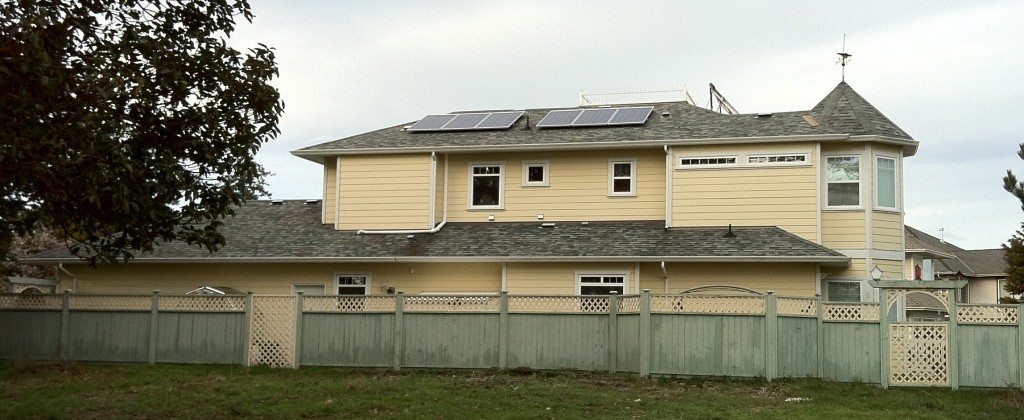TOP TEN eco HOME Innovations:
The last ten years has seen a sharp increase in people who are interested in conserving energy and preserving the environment by living “green” or “eco.” There are many things you can do to reduce your carbon footprint and help make the earth a better place for future generations. Here are ten ‘eco’logical suggestions.

1. Going Solar Adding solar panels to your home is one of the most important things you can do to reduce your carbon footprint. All energy has to come from somewhere, and the sun is the safest and most sustainable energy source that we have. Converting to solar electric power or solar hot water may seem expensive, but government incentives have led many installation companies to offer payment plans that are roughly equal to your monthly electric bill. After you’ve paid off your solar panels, you can “harvest” the extra energy you produce and actually watch your electric meter run in reverse.
2. Heating and Cooling Heating and cooling expenses account for the largest portion of most homeowner’s energy bills. Replacing old or outdated furnaces and air conditioning units can increase energy efficiency and lower costs. Geothermal heating and heat pumps employ cutting-edge technology to use temperature differentials within the earth, air or water to heat your home. Although expensive, it is undoubtedly the wave of the future and is already very common throughout Europe.
3. LED Lighting While replacing standard incandescent or compact fluorescent bulbs with LED lamps will initially cost more, these long-lasting lamps will eventually pay for themselves through life cycle energy savings. LED’s can now also produce a cleaner, more natural light than fluorescent light bulbs.
4. Water Recycling Water is a hot topic, especially as climate change becomes more prevalent. Water filters are available to clean and reuse water from showers and baths, dishes and laundry. These ‘Gray Water’ systems redirect the used water from these various types of washing to toilets, lawns or gardens.
5. eco Insulation Replacing wall and attic insulation in older homes is another way to cut energy usage and costs. Choose eco-certified batt insulation like Roxul or loose fill cellulose insulation. No ‘safe’ spray foam insulations exist at this time.
6. Low VOC Stains and Paints Paints and stains with high levels of volatile organic compounds create pollution when they are manufactured, and they can release harmful chemicals into the atmosphere and the air within your home on hot, humid days. Whenever possible, use low VOC or VOC-free paints and stains inside your home.
7. Portability, Size and Location Modular and prefabricated homes manufactured with eco materials are one way to ensure your house is environmentally friendly. In addition, many people are choosing to buy, build or rent smaller homes, condos or apartments in walkable districts to reduce their environmental impact.
8. Alternative Materials Using non-traditional materials like pumice cloth or fibreglass to manufacture homes is becoming increasingly popular. Working with materials like these can reduce our reliance on natural resources and energy.
9. Rainwater Collection Another way to reduce water use is to utilize a cistern or holding tank to collect rainwater. Once gathered, the water can be purified for home use, or more commonly, used to irrigate gardens, landscaping and lawns.
10. Air Purification In recent years indoor air pollution has gotten a lot of attention. Building materials and embellishments like paint and carpets can off-gas chemical compounds into the atmosphere, and because a home is an enclosed space, those compounds can sometimes accumulate to dangerous levels. Installing a whole-house air purification system is one way to keep indoor air clean and circulating. Indoor plants act aseffective natural air filters.
11. Sustainable Wood (Oops there’s 11 good tips!) When beginning any new construction project, it’s important to look for lumber that is sustainable. That is, it is harvested from trees that are grown specifically for timber, and not logged from old-growth forests. For wooden floors or paneling, consider using an inexpensive, fast-growing, beautiful and sustainable wood like bamboo or cork.
Going “eco” doesn’t have to be a challenge. A home is a long-term investment. You don’t have to start over from scratch. Make small changes. Choose environmentally friendly paint or LED bulbs. Chances are your home will need improvements eventually. Whenever possible, choose upgrades that will reduce your carbon footprint. It’s good for the planet, and it’s good for you.
With thanks for the original idea to Douglas Elliman Realtors, New York City Luxury Real Estate



Leave a Reply
Want to join the discussion?Feel free to contribute!